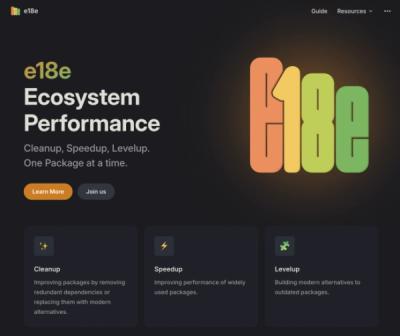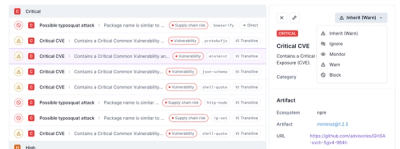
Research
Security News
Malicious npm Package Typosquats react-login-page to Deploy Keylogger
Socket researchers unpack a typosquatting package with malicious code that logs keystrokes and exfiltrates sensitive data to a remote server.
@aws-cdk/cdk
Advanced tools
Changelog
Readme
This library includes the basic building blocks of the AWS Cloud Development Kit (AWS CDK).
Aspects are a mechanism to extend the CDK without having to directly impact the class hierarchy. We have implemented aspects using the Visitor Pattern.
An aspect in the CDK is defined by this interface
Aspects can be applied to any construct. During the tree
"prepare" phase the aspect will visit each construct in the tree once.
Aspects are invoked in the order they were added to the construct. They
traverse the construct tree in a breadth first order starting at the App
ending at the leaf nodes (most commonly the CloudFormation Resource). Aspect
authors implement the visit(IConstruct) function and can inspect the
Construct for specific characteristics. Such as, is this construct a
CloudFormation Resource?
Tags are implemented using aspects.
Tags can be applied to any construct. Tags are inherited, based on the scope. If you tag construct A, and A contains construct B, construct B inherits the tag. The Tag API supports:
Tag add (apply) a tag, either to specific resources or all but specific resourcesRemoveTag remove a tag, again either from specific resources or all but specific resourcesA simple example, if you create a stack and want anything in the stack to receive a tag:
import cdk = require('@aws-cdk/cdk');
const app = new cdk.App();
const theBestStack = new cdk.Stack(app, 'MarketingSystem');
theBestStack.node.apply(new cdk.Tag('StackType', 'TheBest'));
// any resources added that support tags will get them
The goal was to enable the ability to define tags in one place and have them applied consistently for all resources that support tagging. In addition the developer should not have to know if the resource supports tags. The developer defines the tagging intents for all resources within a path. If the resources support tags they are added, else no action is taken.
We are going to use the ECS example as starting point.
For the purposes of example, this ECS cluster is for the Marketing Department. Marketing has two core groups Business to Business (B2B) and Business to Consumer (B2C). However, the Marketing team relies on the Platform team to help build the common components across businesses and separates costs to match. The goal here is tag the Platform team resources, the Marketing Department and then Marketing groups to enable proper cost allocations.
We have modified the example and the code is located: examples/cdk-examples-typescript/hello-cdk-ecs-tags
When the example is run the following tags are created:
We are omitting the default tags for VPC components.
| Construct Path | Tag Key | Tag Value |
|---|---|---|
| MarketingSystem/MarketingVpc | CostCenter | Platform |
| MarketingSystem/MarketingVpc/PublicSubnet1 | CostCenter | Platform |
| MarketingSystem/MarketingVpc/PublicSubnet1/RouteTable | CostCenter | Platform |
| MarketingSystem/MarketingVpc/PublicSubnet1/NATGateway | CostCenter | Platform |
| MarketingSystem/MarketingVpc/PublicSubnet2 | CostCenter | Platform |
| MarketingSystem/MarketingVpc/PublicSubnet2/RouteTable | CostCenter | Platform |
| MarketingSystem/MarketingVpc/PublicSubnet2/NATGateway | CostCenter | Platform |
| MarketingSystem/MarketingVpc/PublicSubnet3 | CostCenter | Platform |
| MarketingSystem/MarketingVpc/PublicSubnet3/RouteTable | CostCenter | Platform |
| MarketingSystem/MarketingVpc/PublicSubnet3/NATGateway | CostCenter | Platform |
| MarketingSystem/MarketingVpc/PrivateSubnet1 | CostCenter | Platform |
| MarketingSystem/MarketingVpc/PrivateSubnet1/RouteTable | CostCenter | Platform |
| MarketingSystem/MarketingVpc/PrivateSubnet2 | CostCenter | Platform |
| MarketingSystem/MarketingVpc/PrivateSubnet2/RouteTable | CostCenter | Platform |
| MarketingSystem/MarketingVpc/PrivateSubnet3 | CostCenter | Platform |
| MarketingSystem/MarketingVpc/PrivateSubnet3/RouteTable | CostCenter | Platform |
| MarketingSystem/MarketingVpc/IGW | CostCenter | Platform |
| MarketingSystem/B2BService/Service/SecurityGroup/Resource | CostCenter | Marketing |
| MarketingSystem/B2BService/LB/Resource | CostCenter | Marketing |
| MarketingSystem/B2BService/LB/SecurityGroup/Resource | CostCenter | Marketing |
| MarketingSystem/B2BService/LB/PublicListener/ECSGroup/Resource | CostCenter | Marketing |
| MarketingSystem/B2CService/Service/SecurityGroup/Resource | CostCenter | Marketing |
| MarketingSystem/B2CService/LB/Resource | CostCenter | Marketing |
| MarketingSystem/B2CService/LB/SecurityGroup/Resource | CostCenter | Marketing |
| MarketingSystem/B2CService/LB/PublicListener/ECSGroup/Resource | CostCenter | Marketing |
As you can see many tags are generated with only a few intent based directives. The CDK does default some additional tags for suggested Name keys. If you want to remove those tags you can do so by using the RemoveTag aspect, see below:
// snip //
const vpc = new ec2.VpcNetwork(marketingStack, 'MarketingVpc', {
maxAZs: 3 // Default is all AZs in region
});
// override the VPC tags with Platform
// this will tag the VPC, Subnets, Route Tables, IGW, and NatGWs
vpc.node.apply(new cdk.Tag(COST_CENTER_KEY, 'Platform'));
vpc.node.apply(new cdk.RemoveTag('Name'));
// snip //
This will remove the name tags from the VPC, subnets, route tables and NAT gateways. If you've been following closely, this may lead you to ask how does remove work when the tag is actually applied closer to the resource? The Tag API has a few features that are covered later to explain how this works.
In order to enable additional controls a Tags can specifically include or
exclude a CloudFormation Resource Type, propagate tags for an autoscaling group,
and use priority to override the default precedence. See the TagProps
interface for more details.
This property is a boolean that defaults to true. When true and the aspect
visits an AutoScalingGroup resource the PropagateAtLaunch property is set to
true. If false the property is set accordingly.
// ... snip
const vpc = new ec2.VpcNetwork(this, 'MyVpc', { ... });
vpc.node.apply(new cdk.Tag('MyKey', 'MyValue', { applyToLaunchedInstances: false }));
// ... snip
Include is an array property that contains strings of CloudFormation Resource Types. As the aspect visits nodes it only takes action if node is one of the resource types in the array. By default the array is empty and an empty array is interpreted as apply to any resource type.
// ... snip
const vpc = new ec2.VpcNetwork(this, 'MyVpc', { ... });
vpc.node.apply(new cdk.Tag('MyKey', 'MyValue', { includeResourceTypes: ['AWS::EC2::Subnet']}));
// ... snip
Exclude is the inverse of include. Exclude is also an array of CloudFormation Resource Types. As the aspect visit nodes it will not take action if the node is one of the resource types in the array. By default the array is empty and an empty array is interpreted to match no resource type. Exclude takes precedence over include in the event of a collision.
// ... snip
const vpc = new ec2.VpcNetwork(this, 'MyVpc', { ... });
vpc.node.apply(new cdk.Tag('MyKey', 'MyValue', { exludeResourceTypes: ['AWS::EC2::Subnet']}));
// ... snip
Priority is used to control precedence when the default pattern does not work.
In general users should try to avoid using priority, but in some situations it
is required. In the example above, this is how RemoveTag works. The default
setting for removing tags uses a higher priority than the standard tag.
// ... snip
const vpc = new ec2.VpcNetwork(this, 'MyVpc', { ... });
vpc.node.apply(new cdk.Tag('MyKey', 'MyValue', { priority: 2 }));
// ... snip
FAQs
Unknown package
The npm package @aws-cdk/cdk receives a total of 140 weekly downloads. As such, @aws-cdk/cdk popularity was classified as not popular.
We found that @aws-cdk/cdk demonstrated a not healthy version release cadence and project activity because the last version was released a year ago. It has 5 open source maintainers collaborating on the project.
Did you know?

Socket for GitHub automatically highlights issues in each pull request and monitors the health of all your open source dependencies. Discover the contents of your packages and block harmful activity before you install or update your dependencies.

Research
Security News
Socket researchers unpack a typosquatting package with malicious code that logs keystrokes and exfiltrates sensitive data to a remote server.

Security News
The JavaScript community has launched the e18e initiative to improve ecosystem performance by cleaning up dependency trees, speeding up critical parts of the ecosystem, and documenting lighter alternatives to established tools.

Product
Socket now supports four distinct alert actions instead of the previous two, and alert triaging allows users to override the actions taken for all individual alerts.